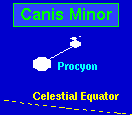The Constellations
Historically, constellations were groupings of stars that were thought to
outline the shape of something, usually with mythological significance. There
are 88 recognized constellations, with their names tracing as far back as
Mesopotamia, 5000 years ago.
The Historical Constellations

 In some cases one can discern easily the purported shape; for example,
the
constellation Leo shown on the right might actually look like a lion with the
dots connected as they are.
In other cases the
supposed shape is very much in the eye of the beholder, as the example of Canis
Minor (The Little Dog) shown on the left indicates.
This certainly could be a little
dog, or a cow, or a submarine, or . . .
In some cases one can discern easily the purported shape; for example,
the
constellation Leo shown on the right might actually look like a lion with the
dots connected as they are.
In other cases the
supposed shape is very much in the eye of the beholder, as the example of Canis
Minor (The Little Dog) shown on the left indicates.
This certainly could be a little
dog, or a cow, or a submarine, or . . .
Star Groupings and Asterisms

Some of the more
familiar "constellations" are technically not constellations at all. For
example, the grouping of stars known as the Big Dipper is probably familiar to
most, but it is not actually a constellation. The Big Dipper is part of a
larger grouping of stars called the Big Bear (Ursa Major) that
is a
constellation.
A well-known grouping of stars like the Big Dipper
that is not officially recognized as
a constellation is called
an asterism.
Constellations Are Not Physical Groupings
The apparent groupings of stars into constellations that we see on the
celestial sphere are not physical groupings. In most cases the stars in
constellations and asterisms
are each very different distances from us, and only appear to be grouped
because they lie in approximately the same direction. This is
illustrated in the
following figure for the stars of the Big Dipper, where their physical distance
from the Earth is drawn to scale (numbers beside each star give the distance
from Earth in light years).

The relative distances to stars in the Big Dipper |
It is important to make this distinction because later we shall consider
groupings that are physical groupings, such as star clusters and
binary star systems.
The Constellations of the Zodiac
The zodiac is an imaginary band 18 degrees wide and centered on the
ecliptic. The constellations that fall in the zodiac are called the
12 constellations of the zodiac.
They were at one time thought to have
great mystical and
astrological significance. Astrology is bunk, but the constellations of the
zodiac are still of importance because the planets, as well as the Sun and
Moon, are all near or on the ecliptic at any given time; thus, they are always
found within one of the zodiac constellations.
Constellations in Modern Astronomy
In modern astronomy, the significance of constellations is no longer
mythological, but practical: constellations define imaginary regions of the
sky, just as the individual states each
define an imaginary region of the United States. Thus,
to say that a planet is in the constellation Leo is to partially locate the
planet on the celestial sphere, just as saying that Knoxville is in Tennessee
is to partially locate the city on the surface of the Earth. As for states,
modern constellations have irregular boundaries that have been agreed upon for
various reasons, perhaps not always completely logical.
Here is a
Web page devoted to
constellations and
their stars, and a
Java applet allowing interactive display of stars and constellations.
See also this
Java applet (select from the list of constellations that appears for a
scrollable map centered on that constellation).
Finally, here is a constellation
pronunciation guide.
Drawing the Constellations
Here are two pieces of software that allow you to construct maps of the sky at
specified times (now, or in the past or future) that include constellations:
-
Starry Night is a $28 shareware program for the Macintosh that simulates
the appearance and motion of the sky from a user chosen vantage point and at a
user chosen time.
-
Free
Star Maps may be
downloaded on demand
from the Mount Wilson Observatory in postscript format. A forms interface
allows the map to be customized, and links on the Mount Wilson page explain how
to download a free postscript viewer if your don't already have one.
Each of these programs can provide information about the celestial
sphere beyond just drawing the constellations.
Here is a
map of
northern hemisphere constellations characteristic of late Winter
evenings in the
Southern United States that was constructed using the Mount Wilson software
described above.


 In some cases one can discern easily the purported shape; for example,
the
constellation Leo shown on the right might actually look like a lion with the
dots connected as they are.
In other cases the
supposed shape is very much in the eye of the beholder, as the example of Canis
Minor (The Little Dog) shown on the left indicates.
This certainly could be a little
dog, or a cow, or a submarine, or . . .
In some cases one can discern easily the purported shape; for example,
the
constellation Leo shown on the right might actually look like a lion with the
dots connected as they are.
In other cases the
supposed shape is very much in the eye of the beholder, as the example of Canis
Minor (The Little Dog) shown on the left indicates.
This certainly could be a little
dog, or a cow, or a submarine, or . . .

